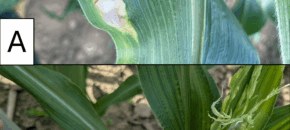Symptoms usually begin to appear on random plants throughout the field as green fruit begins to mature. The bacterium (Pseudomonas corrugata) is ubiquitous to soils and develops when weather conditions (cooler nights/very hot, humid days) and cultural practices (i.e., excess heavy N use) lead to favorable conditions for disease development. Symptoms include the development of […]
Continue reading...Diagnosing Important Diseases In Tomato – Reference Guide
The following images consist of important diseases in tomato. These images can be used as a quick reference for diagnosing important fungal and bacterial pathogens. For best results, please turn your device (i.e., cell phone) sideways. For information on commercial control recommendations, please visit the tomato section of the 2022/2023 Mid-Atlantic Commercial Vegetable Production Guide. […]
Continue reading...Veg IPM Update 7/25/25

Greetings from the Veg IPM team! Sweet Corn Corn earworm moth captures are increasing, leading to 3- or 4-day spray intervals being needed throughout the state. When temperatures are high (>85 degrees F), shorten the spray interval by one day. Rotation is important for avoiding resistance, and there are four IRAC groups that are registered […]
Continue reading...Diagnosing important diseases in Pepper – Reference Guide
Phytophthora blight causing plants to wilt and die Phytophthora blight – crown rot Phytophthora crown rot. Note the blackish-brown necrotic tissue at base of the stem Phytophthora sporulating on infected bell pepper fruit. Phytophthora fruit rot (L) and Pythium blight (R) Symptoms of Phytophthora blight on infected leaves. Under ideal conditions leaf infections can occur. […]
Continue reading...Avoiding Plectosporium blight in cucurbit fields
Plectosporium blight, also known as Microdochium blight or White speck, caused significant problems in some pumpkin fields the last few summers in New Jersey. The soil-borne fungal pathogen, although somewhat uncommon, can unexpectedly show up in some years and cause significant losses if left uncontrolled. The fungus survives in the soil on decaying plant debris […]
Continue reading...Recognizing Angular Leaf Spot in Cucurbits
Angular leaf spot, caused by the bacterium (Pseudomonas syringae pv. lachrymans), is common in New Jersey and the region. Although it often shows up during cooler, wet weather; it can show up almost anytime during the production season with favorable weather conditions for its development. Angular leaf […]
Continue reading...